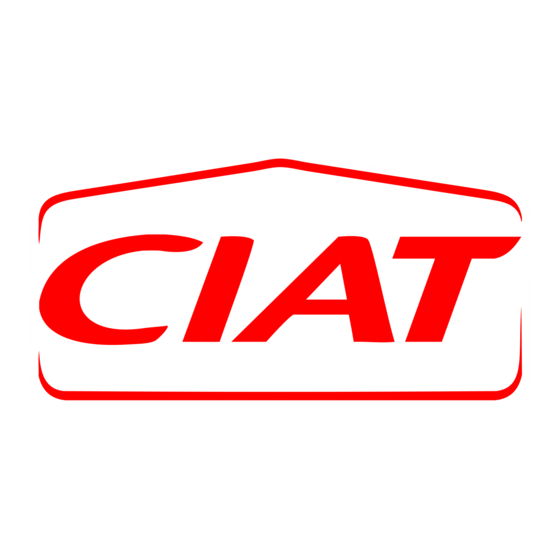
Table of Contents
Advertisement
Advertisement
Table of Contents

Summarization of Contents
Receiving and Handling the Unit
Unit Unloading Procedure
Procedure for safely removing the unit from the delivery vehicle.
Handling Safety Guidelines
Essential safety precautions to be observed during installation and operation.
Installation Site Selection and Requirements
Installer Warnings and Instructions
Critical advice for installers regarding compliance and unit operation.
Choosing the Optimal Location
Guidance on selecting a site considering environmental factors and public access.
Location-Specific Precautions
Details on avoiding vegetation, hot air sources, and maintaining air intake/discharge paths.
Required Clearances for Operation
Details on necessary clearances around the chiller for air circulation and maintenance.
Unit Handling and Lifting
Proper Lifting Point Identification
Using only marked lifting points and avoiding removal of fitted accessories.
Safe Handling Practices
Preventing damage during handling to maintain operational integrity.
Installation Best Practices
Recommended Lifting Shackles
Specification of the recommended shackle for safe unit lifting.
Site Safety and Risk Mitigation
Steps to limit failure consequences and ensure site-specific safety rules are met.
Vibration Isolation and Mounting
Instructions for installing anti-vibration mounts under the chiller for low vibration applications.
Protection and Securing the Unit
Measures for unit protection from elements, securing it, and proper piping connection.
Emergency Stop and Electrical Safety
Ensuring an emergency stop is fitted and electrical connections are safe and compliant.
Piping, Draining, and Earthing
Guidelines for piping, venting, draining, and earthing connections, including lightning protection.
Hydraulic System
Hydraulic Connection Guidelines
Instructions for making secure and clean hydraulic connections, avoiding residues.
Hydraulic Diagram Overview
Schematic representation of the unit's hydraulic circuit, showing components.
Hydraulic Pump Specifications
Tables detailing power and current for single and dual pump configurations across models.
Chiller and Free Cooling Module Performance
High-Performance (HP) Model Data
Cooling capacity, power consumption, EER, and sound levels for HP versions.
Low Noise (LN/XLN) Model Data
Performance metrics for LN and XLN chiller and free cooling module variants.
Chiller Technical Specifications
Compressor and Refrigerant Details
Technical data for compressors, refrigerant oil, and refrigerant load.
Electrical and Control Parameters
Specifications for electrical supply, machine protection, and control circuit.
Evaporator and Condenser Specifications
Data on evaporator water capacity, condenser fan details, and air flow.
Water System Connections and Flow
Information on water connections, flow rates, and maximum pressure.
Free Cooling Module Technical Data
High-Performance (HP) Module Specs
Technical data for HP free cooling modules, including coil, fan, and air flow.
Low Noise (LN/XLN) Module Specs
Technical data for LN/XLN free cooling modules, including coil, fan, and air flow.
Electrical Characteristics
Compressor Electrical Load
Maximum nominal and starting currents for compressors across various models.
Fan Motor Current Ratings
Nominal current ratings for fan motors in HP and LN/XLN versions.
Free Cooling Fan Current
Nominal current ratings for free cooling fans in HP and LN/XLN versions.
Unit Operation and Commissioning
First Commissioning Steps
Step-by-step guide for initial unit startup and essential checks.
Troubleshooting Common Issues
Checks to perform when anomalies occur to identify potential causes.
Usage Recommendations
Advice on using treated water and preparing motors for prolonged inactivity.
Maintenance Procedures
General Maintenance Advice
Guidelines for safe and effective maintenance, emphasizing qualified personnel.
Motor Maintenance and Drying
Specific instructions for inspecting and drying the unit's motors.
Maintenance Task Schedule
Recommended frequency for routine maintenance tasks like retightening bolts and cleaning.
Unit Destruction and Disposal
Safe Disconnection and Draining
Procedure for safely disconnecting the unit and draining it per environmental standards.
Lifting During Disposal
Recommendation to use original lifting rings and consult agent for lost markings.
Key Operational Risks
Risks: Lifting and Positioning
Warning about accidents related to lifting and positioning the unit.
Risks: Grille Removal
Warning about potential injuries from removing unit grilles.
Risks: Casing Opening
Warning about electrocution hazards when opening the unit's casing.
Risks: Contact with Pipes
Warning about burn hazards from touching hot pipes.







Need help?
Do you have a question about the LDH 900V and is the answer not in the manual?
Questions and answers